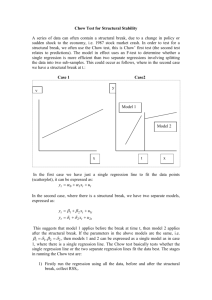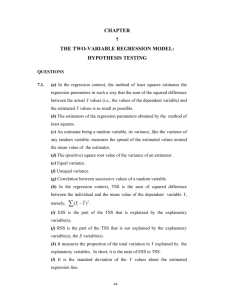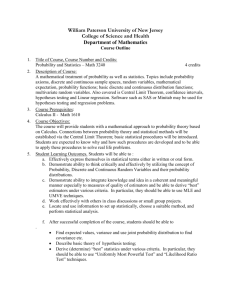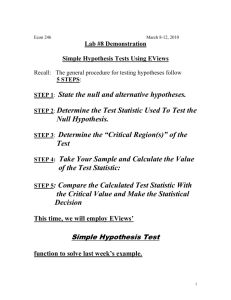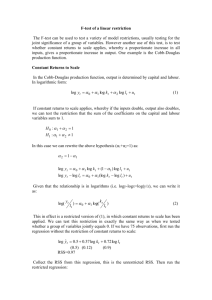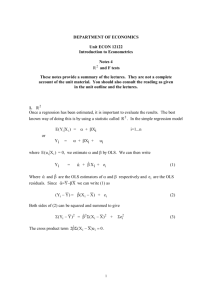The 2 and F distributions
advertisement
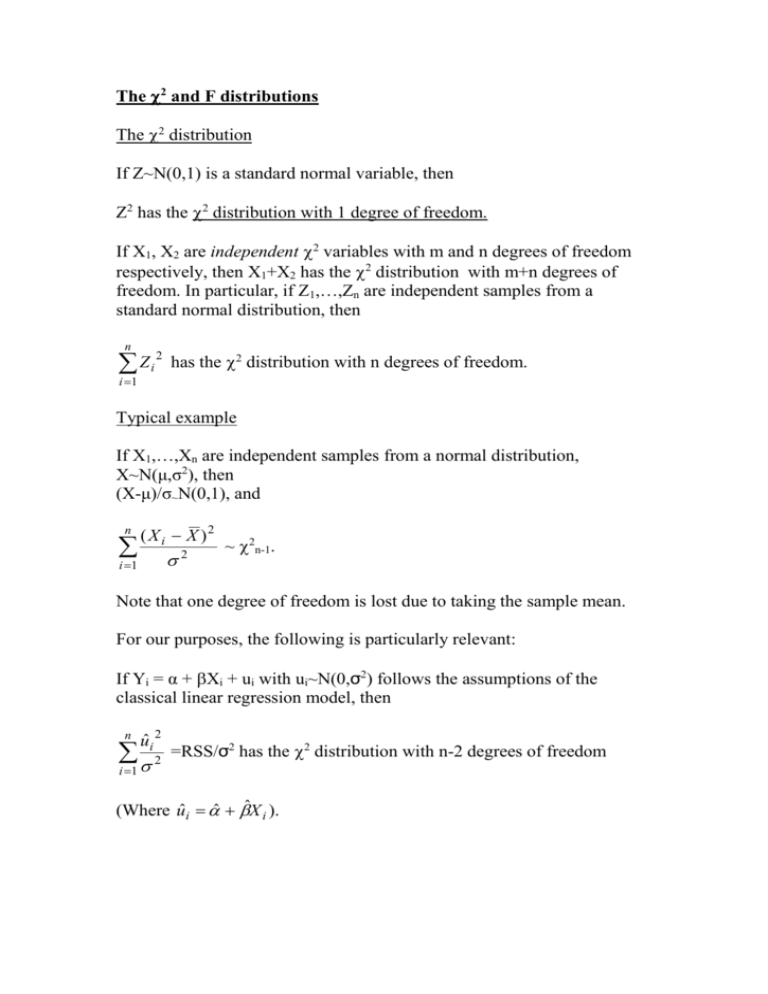
The 2 and F distributions The 2 distribution If Z~N(0,1) is a standard normal variable, then Z2 has the 2 distribution with 1 degree of freedom. If X1, X2 are independent 2 variables with m and n degrees of freedom respectively, then X1+X2 has the 2 distribution with m+n degrees of freedom. In particular, if Z1,…,Zn are independent samples from a standard normal distribution, then n Zi 2 has the 2 distribution with n degrees of freedom. i 1 Typical example If X1,…,Xn are independent samples from a normal distribution, X~N(μ,σ2), then (X-μ)/σ~N(0,1), and n ( X i X )2 i 1 2 ~ 2n-1. Note that one degree of freedom is lost due to taking the sample mean. For our purposes, the following is particularly relevant: If Yi = α + Xi + ui with ui~N(0,σ2) follows the assumptions of the classical linear regression model, then n uˆi 2 2 =RSS/σ2 has the 2 distribution with n-2 degrees of freedom i 1 (Where uˆi ˆ ˆX i ). In general, if we have k explanatory variables, X1,…,Xk in our regression n uˆi 2 model, then 2 ~ 2n-k-1. i 1 Relationship between the t-statistic and the 2 statistic The t-distribution is initially defined in terms of the standard normal and the 2 distribution. Let Z~N(0,1), and let X~2n , with the two variables independent. Then Z has the t-distribution with n degrees of freedom. X /n Example: Let X1,…,Xn be independent samples from a normal distribution, Xi~N(μ,σ2). Then (X ) ~N(0,1) ( / n ) n While ( X i X )2 i 1 2 ~ 2n-1. It can be shown that these two variables are independent. Hence, (X ) ( / n ) n ( X i X ) 2 /(n 1) i 1 (X ) n ( X i X ) 2 /(n 1) n i 1 (X ) (X ) = ~ tn-1, which is exactly how we introduced the tˆ 2 / n S .E.( X ) distribution in the first place. = For regression purposes, we know that the regression coefficient 2 ˆ ˆ ˆ ~N(,Var( )), where Var( )= n ( X i X )2 i 1 Hence ( ˆ ) ~ N(0,1). 2 ( X i X )2 n uˆi 2 2 We also have that ~ 2n-2 , and it can be shown that these two i 1 variables are independent. Dividing the standard normal variable by the root of the 2 variable over its degrees of freedom, and cancelling the sigma, we get ( ˆ ) ( uˆi 2 ) /( n 2) ( X i X )2 ( ˆ ) ˆ 2 / ( X i X ) 2 = ( ˆ ) S .E.( ˆ ) Has the t-distribution with n-2 degrees of freedom. A similar result holds for the k-variable case. The F-distribution Let X1 and X2 be independent 2 variables with n1 and n2 degrees of freedom respectively. Then (X1/n1)/(X2/n2) has the F-distribution with (n1,n2) degrees of freedom. The F-distribution can be used for comparing the variances of two normal distributions. In regression analysis, it is absolutely crucial, for testing restrictions on the regression model, and in particular, testing the restriction that all the explanatory variables are insignificant. n 2 We have already seen that the RSS/σ , uˆi 2 2 i 1 ~ 2n-k-1. It can be shown that, in the classical regression model, the Explained Sum (Yˆi Y ) 2 2 of Squares (ESS) divided by σ , that is has the 2 2 distribution with k degrees of freedom, under the assumption of the null hypothesis, that all the explanatory variables are insignificant, that is that the true values of 1,…,k are zero. Hence, dividing and cancelling the σ2, we get that, under the null hypothesis F ESS / k ~F(k,n-k-1) RSS /( n k 1) We may therefore compare the resulting F statistic with the 95% or 99% etc. critical value of the appropriate F distribution. If the F-statistic exceeds this critical value, we may reject the null hypothesis that 1=2=….=k=0, and conclude that the regression as a whole is significant, that is that the variables X1,…,Xk are jointly significant. It is possible for a set of variables to be jointly significant, even if they are all individually insignificant. This is particularly likely if there is a very close relationship between the X-variables (multicolinearity); it may be possible to tell that the variables together are insignificant, but impossible to separate out the effect of just one of them, because they are so closely linked. E.g. consider the effect of income and wealth on consumption – income and wealth are very strongly correlated, so while they would certainly be jointly significant, it may be impossible to separate out their effects. More generally, suppose we have a model with a number of X variables, and we wish to test the hypothesis that some of them are jointly insignificant. That is, suppose we estimate the model Yi = α+1X1i+…+kXki + ui , and we wish to test the hypothesis that 1 = … = l =0, with l≤k – that is, we are testing the hypothesis that X1,…,Xl are jointly insignificant. It can be shown that the difference between the RSS obtained with the original model, and the RSS obtained with the restricted model (with the first l variables removed), divided by σ2, has the 2 distribution with l degrees of freedom, under the null hypothesis that 1 = … = l =0. Let RSS1 be the RSS obtained with the unrestricted model, and let RSS2 be the RSS from the restricted model, that is with 1=…=l=0. Then under the null hypothesis, F= ( RSS2 RSS1 ) / l ~ F(l,n-k-1). RSS1 /( n k 1) (Note that RSS2 will be greater than RSS1 – since we have fewer variables in the restricted model, the residuals will be higher.) We may therefore compare this F statistic with the appropriate critical value of the F distribution. If the statistic exceeds the 95% (or 99% or whatever) critical value, then we may reject the null hypothesis, and conclude that the deleted variables, X1,…,Xl, are in fact significant. More generally still, the same statistic can be used when testing any l linear restrictions on the model – for example, a linear restriction may take the form 1=1, or 1+2=0, etc. Here, RSS2 is the RSS from the regression obtained by imposing these restrictions, that is by calculating the least squares estimators based on the requirement that these are true. For example, suppose our model is Yi = α+1X1i+2X2i+3X3i + ui, and we are testing the hypothesis that 1=1 and 2+3=0, then the restricted model involves finding estimators for the model Yi=α + X1i + 2X2i - 2X3i + ui. Hence we choose α and 2 to minimise the sum of square error.


